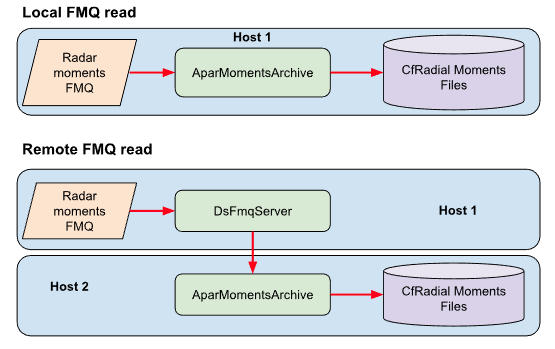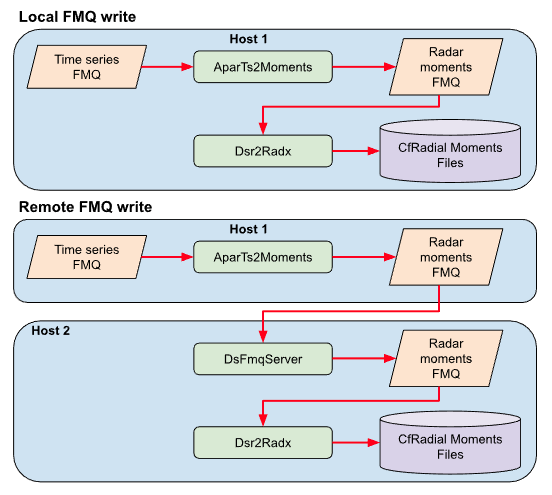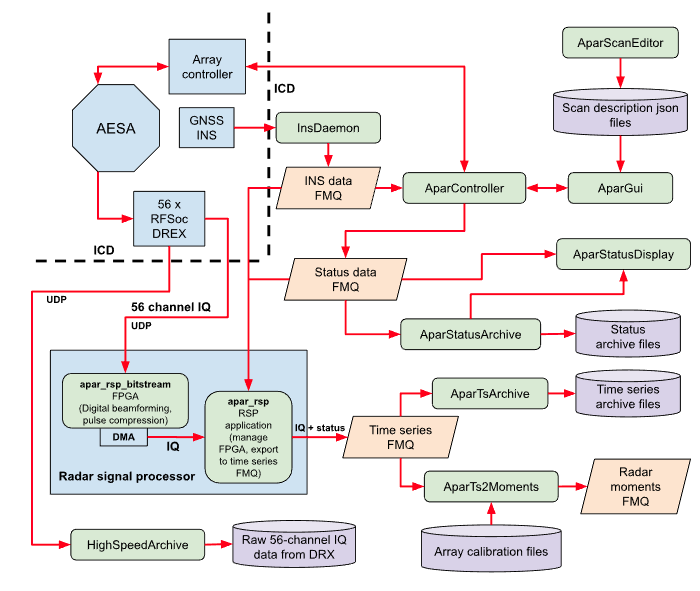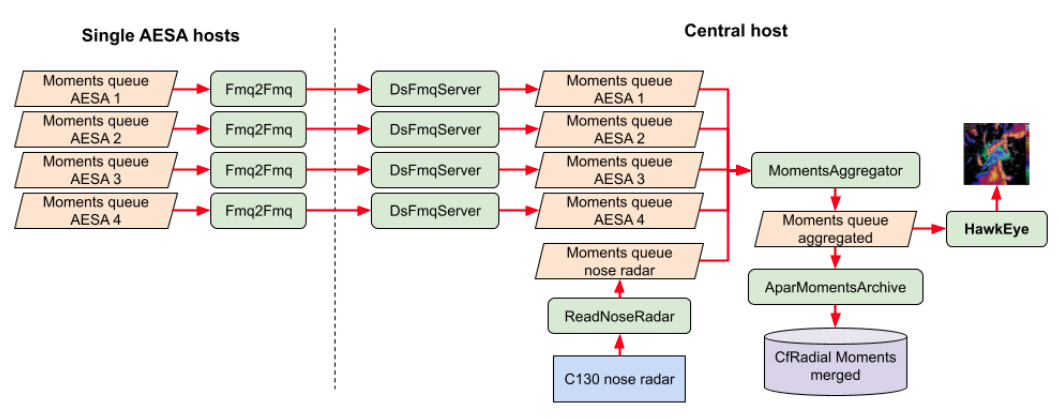lrose-docs
Documentation for LROSE
This project is maintained by NCAR
Data flow and triggering in real-time operations
Overview
There are a number of components that make up the LROSE realtime data flow and triggering system.
| Component | Description |
|---|---|
| FMQ | Fast Message Queue. Passes message-based data from one process to the next. |
| Data Files | Applications read a file, process the data, write file(s). File formats include: (a) IWRF time series, (b) CfRadial NetCDF for polar radar data, (c) CF-compliant NetCDF for Cartesian data, (d) XML, (e) various binary formats (e.g. Titan). |
| latest_data_info | Files and FMQ keeping track of latest data as written to the disk. |
| DataMapper | Stores current state of data system. This is a server. Applications register with DataMapper when they write data. |
| PrintDataMap | App to print the DataMapper status. |
The Fast Message Queue (FMQ)
The Fast Message Queue (FMQ) is fundamental to the real-time operations in LROSE. It allows messages to be written to a queue by a single writer, and read by multiple readers. This allows data streams to be fed to multiple applications. Reads are implemented via efficient polling, which makes FMQs lightweight in terms of CPU usage.
FMQ is implemented by the Fmq (and DsFmq) classes in the libs/Fmq library.
An FMQ comprises 2 circular buffers:
- stat: index of message status details in main buffer containing the messages.
- buf: main buffer containing the messages.
There is also a .lock file, which guarantees a single writer.
A message is contiguous array of bytes, in any arbitrary format. The applications need to know and understand the contents of the messages.
The status queue comprises a status header (q_stat_t) followed by an array of slots (q_slot_t), one slot for each message in the main buffer. (The FMQ slots precede the QT SLOT mechanism and are unrelated.)
The status header definition is:
typedef struct {
si32 magic_cookie; /* magic cookie for file type */
si32 youngest_id; /* message id of last message written */
si32 youngest_slot; /* num of slot which contains the
* youngest message in the queue */
si32 oldest_slot; /* num of slot which contains the
oldest message in the queue */
si32 nslots; /* number of message slots */
si32 buf_size; /* size of buffer */
si32 begin_insert; /* offset to start of insert free region */
si32 end_insert; /* offset to end of insert free region */
si32 begin_append; /* offset to start of append free region */
si32 append_mode; /* TRUE for append mode, FALSE for insert mode */
si32 time_written; /* time at which the status struct was last
* written to file */
/* NOTE - blocking write only supported for 1 reader */
si32 blocking_write; /* flag to indicate blocking write */
si32 last_id_read; /* used for blocking write operation */
si32 checksum;
} q_stat_t;
The slot definition is:
// FMQ slot struct
// Messages are stored in the buffer as follows:
// si32 si32 si32
// --------------------------------------------------------
// | magic cookie | slot_num | -- message -- | pad | id |
// --------------------------------------------------------
// Pad is for 4-byte alignment.
typedef struct {
si32 active; /* active flag, 1 or 0 */
si32 id; /* message id 0 to FMQ_MAX_ID */
si32 time; /* Unix time at which the message is written */
si32 msg_len; /* message len in bytes */
si32 stored_len; /* message len + extra 12 bytes (FMQ_NBYTES_EXTRA)
* for magic-cookie and slot num fields,
* plus padding out to even 4 bytes */
si32 offset; /* message offset in buffer */
si32 type; /* message type - user-defined */
si32 subtype; /* message subtype - user-defined */
si32 compress; /* compress mode - TRUE or FALSE */
si32 checksum;
} q_slot_t;
NOTE
Some of the struct members (time_written, buf_size, begin_insert, end_insert, begin_append, time, msg_len, stored_len, offset) need to be updated to 64-bit integers.
youngest_slot, oldest_slot and nslots must remain type si32 (int) to ensure atomic read/writes. This is not a limitation, since we would never need more that a billion slots.
An FMQ can be either file-based or shared-memory based.
| FMQ type | Speed | Description |
|---|---|---|
| file | slower | 2 files: name.stat (status queue) and name.buf (message queue). The FMQ path includes the fmq name. For example /tmp/fmq/moments/long_pulse. The files would be /tmp/fmq/moments/long_pulse.stat and /tmp/fmq/moments/long_pulse.buf. |
| shmem | faster | 2 buffers in one shared memory segment. FMQ path included the text ‘shmem’ followed by the shmem key. For example /tmp/fmq/ts/short_pulse/shmem_10002. Shared memory key is 10002. A lock file is created in the directory. In this case it would be /tmp/fmq/ts/short_pulse/shmem_10002.lock. |
Configuring an FMQ
When creating an FMQ, it must be configured to handle the characteristics of the data. You need to ask:
- how large are the messages?
- how fast are the messages arriving?
- how fast will the readers be able to comsume the messages?
The following parameters must be set when creating an FMQ:
| Parameter | Typical value | Description |
|---|---|---|
| numSlots | 1000 | The number of slots in the status queue. The FMQ will wrap when the number of slots is exceeded. |
| bufSize | 10M | The size of the message buffer. The FMQ will wrap when the buffer has been filled, and the messages start again at the start of the buffer. |
| compress | false | Option to compress the messages before storing in the buffer. |
| blocking | false | Option to block write to avoid wrapping. Should be used in archive mode only, not real-time. Only works with a single reader. In real-time operations, if the reader falls behind, it is essential to wrap and lose data because it is not possible to catch up. In archive operations, we can afford to wait for the reader. |
In real-time mode, you need to ensure that both numSlots and bufSize are large enough to prevent wrapping in your applications. With modern systems it is practical to set numSlots to 10,000 or more, and bufSize to 100M, 1G or more. In real-time mode, it does not really matter whether the status queue or message buffer wraps first.
In archive mode with blocking set to true, the blocking is implemented on the status buffer. It is important to ensure that the status buffer wraps first, by setting the number of slots to a low number, say 10 to 100. The message buffer should be set large enough to easily accommodate the number of messages (numSlots).
Remote message transfer between hosts
When writing applications that use an FMQ, we generally use the DsFmq class. This inherits Fmq, but adds in the capability to either (a) read FMQ messages from a different host or (b) write messages to a different host.
The DsFmqServer application is a server that helps to implement remote read and write operations via an FMQ.
The figure below shows the implementation of a local and remote read:

The figure below shows the implementation of a local and remote write:

Example of FMQs in action - APAR realtime operations
The following figure is a good example of FMQs in use in a real-time system:

Monitoring an FMQ - FmqMon
The FmqMon application allows you to monitor the activity of an FMQ, regardless of the contents of the messages.
The usage is as follows:
Usage: FmqMon [options as below]
options:
[ --, -h, -help, -man ] produce this list.
[ -debug ] print debug messages
[ -int ? ] specify monitor interval (secs)
[ -mode ? ] specify output mode: SUMMARY, FULL, ASCII_PRINT
SUMMARY: nmessages and data rate
FULL: info on each message
ASCII_PRINT: assumes messages are ASCII, prints messages
[-start] Seek to start of FMQ
If not set, reading begins at the end of the FMQ.
[ -url/-fmq ? ] specify URL of fmq to watch
[ -verbose ] print verbose debug messages
As an example, on the APAR simulator, if we run the command:
FmqMon -fmq /tmp/fmq/ts/long_pulse/shmem_10000 -c 5
we get something like the following:
======================================================================
Dtime nMess nBytes nBytes Rate B/s Rate B/s
secs uncomp comp uncomp comp
===== ===== ====== ====== ======== ========
2024/04/01 21:53:19 5 1028 39867856 39880192 7973571 7976038
2024/04/01 21:53:24 5 1251 48516608 48531620 9703321 9706324
2024/04/01 21:53:29 5 1259 48829888 48844996 9765977 9768999
2024/04/01 21:53:34 5 1251 48518520 48533532 9703704 9706706
2024/04/01 21:53:39 5 1259 48825392 48840500 9765078 9768100
2024/04/01 21:53:44 5 1263 48986752 49001908 9797350 9800381
2024/04/01 21:53:49 5 1251 48516464 48531476 9703292 9706295
2024/04/01 21:53:54 5 1259 48829728 48844836 9765945 9768967
2024/04/01 21:53:59 5 1251 48518520 48533532 9703704 9706706
2024/04/01 21:54:04 5 1259 48825536 48840644 9765107 9768128
2024/04/01 21:54:09 5 1263 48986912 49002068 9797382 9800413
This data is not compressed. The slight difference between the uncompressed and compressed results is that in the FMQ, getting the compressed length adds some housekeeping bytes to the buffer length.
File-based operations - using the latest_data_info mechanism to trigger downstream processes
FMQs are efficient for the passing of data as messages between processes.
For many operations, however, it makes sense for an upstream process to write a file and a downstream process to read that file. In these cases we need an efficient mechanism for triggering the downstream process.
For this we use the latest_data_info concept. This began life as simple ASCII files named _latest_data_info, but has since grown to include XML files, and XML messages passed via FMQs specfically for this purpose.
The latest_data_info files and FMQ are written to the same directory to which the files are written. In such a directory you will find the following files:
| File | Description |
|---|---|
| _latest_data_info | Original simple ASCII file. No longer used. |
| _latest_data_info.xml | XML version, shows the latest data info for the last file written. |
| _latest_data_info.stat | Status file for latest_data_info FMQ. |
| _latest_data_info.buf | Message buffer file for latest_data_info FMQ. |
| _latest_data_info.lock | Lock file for latest_data_info FMQ. |
We need the FMQ funtionality because the downstream processes mauy get busy at times, and potentially miss a file. Having the queue means this is much less likely to occur.
By default the _latest_data_info FMQs have 2500 slots, and a buffer size of (2500 * 500) bytes. The XML messages are of the order of 500 bytes long. So this provides enough space for 2500 messages.
The following figure shows an example of how the latest_data_info mechanism is implemented and used.

The writer applications use the DsLdataInfo class to wite the _latest_data_info files to the local directory. This also registers the write state with the DataMapper. The reader applications poll the _latest_data_info FMQ to obtain information on the latest files written.
NOTE
The FMQ functionality for _latest_data_info is implemented via the following classes:
| Class | Library | Note |
|---|---|---|
| LdataInfo | didss | File-based FMQ only. |
| DsLdataInfo | dsserver | Inherits from LdataInfo. Registers with DataMapper on write. |
These are not based on the libs/Fmq classes.
Example of muhltiple remote FMQs
The following figure shows an example of multiple FMQs being replicated on a remote host, and then combined into a single FMQ to aggregate the data for display and analysis purposes.

Distributing files to remote hosts
LROSE has good capabilities for transferring files to remote hosts, while preserving the latest_data_info.
The DsFileDist application can scan an entire tree of files, searching for new files that need to be copied to remote hosts. The action of DsFileDist is controlled by a top-level parameter file, plus parameter files (_DsFileDist.params) imbedded in the data tree that provide fine-grained control of the file copy mechanism.
The DsFCopyServer is a server that runs on the target host, reading data messages from DsFileDist, writing the data files to disk, writing the latest_data_info files and updating the DataMapper on the target host.
The following figure shows an example of DsFileDist being used to copy multiple CfRadial files from individual APAR panels to a central host, where they are combined into a single data set for display and analysis purposes.
